
Henrietta Lacks: The Woman Whose Cells Advanced Medicine
In 1951 a Black woman went to Johns Hopkins Hospital for treatment for stomach pain. She was diagnosed with an advanced stage of cervical cancer. The woman died nine months later.
Before she died, and without the knowledge of her family, a surgeon took a sample of her cells. Scientists had been trying, for decades, to keep human cells alive outside the human body. The cells always died but not this time. The cells taken from that woman were the first to survive outside a human body and reproduce in a laboratory.
Those cells, according to science writer Rebecca Skloot “launched a medical revolution and a multimillion-dollar industry.
The woman, from whom those cells were taken, was Henrietta Lacks. Henrietta was born in Roanoke, Virginia in 1920. When the United States entered World War II, she and her husband, David migrated north to take advantage of work opportunities in the steel industry. They settled in Turner Station, Baltimore, a small community of Black steelworkers about twenty miles from downtown Baltimore.

When Henrietta began experiencing severe stomach pains, David took her to Johns Hopkins Hospital. In segregated Maryland, Johns Hopkins, which was twenty miles away, was the nearest hospital that would treat Black patients.
At that time, it was common practice to take cells from a patient to advance the study of medicine. The cells from Henrietta Lacks were given the name HeLa for the first two letters in her first and last names. HeLa cells have been bought, sold, packaged, and shipped to laboratories around the world. They have been used in research labs to help determine the cause of cancer and to fight cancer. They have been used to develop drugs to treat leukemia, influenza, and Parkinson’s disease. HeLa cells have also been used to help develop the polio vaccine. They have been taken on a space mission to see what would happen to human cells in zero gravity. HeLa cells have been used in over 70,000 medical studies and are the first cells to be successfully cloned.
The use of HeLa cells and the medical advances and breakthroughs, because of them, happened without the knowledge and consent of the Lacks family. Henrietta’s family did not learn that her cells were still alive until 1973 and did not find out they had been commercialized and sold to laboratories around the world until 1975. The cells from Henrietta are a great contribution to science and medicine. Yet her family did not know this or its significance until decades later.
In 2013, more than sixty years after Henrietta’s cells were first taken, the National Institutes of Health finally began discussions with the Lacks descendants about HeLa. Although the family would not receive monetary compensation, it was agreed that scientists, using data from HeLa cells, must acknowledge the contributions of Mrs. Lacks and her family in any publications from their research.
At a news conference Jeri Lacks-Whye, Lacks’ granddaughter, said:
“For more than 60 years our family has been pulled into science without our consent and researchers have never stopped to talk with us to share information with us or give us a voice in the conversation about the HeLa cells until now.”
In his August 7, 2013, blog post, Dr. Francis Collins, Director of the National Institutes of Health wrote:
It’s most unfortunate that Ms. Lacks did not receive the thanks she deserved from researchers during her lifetime. However, I’m glad that we now have a chance to thank the Lacks family for continuing to share her enduring legacy with the biomedical research community. Their generosity extends to the millions of people who have benefited or will benefit in the future, from research using HeLa cells.
Today, Johns Hopkins School of Medicine is working to bring awareness to Henrietta Lacks. The school is designing a building in her honor for their East Baltimore campus.
Learn more about how Johns Hopkins is honoring the legacy of Henrietta Lacks at: https://www.hopkinsmedicine.org/henriettalacks/
Learn more about Henrietta Lacks, her family, and HeLa cells in “The Immortal Life of Henrietta Lacks” by Rebecca Skloot. It is an amazing book and is how I first learned the story of Henrietta Lacks and HeLa.
Kathy Trusty is the founder of Black History Ed Zone, a Black history education company. Its mission is to make it easy for teacher-parents to include Black History throughout the school year.

This content is restricted to site members. If you are an existing user, please login. New users may register below.
